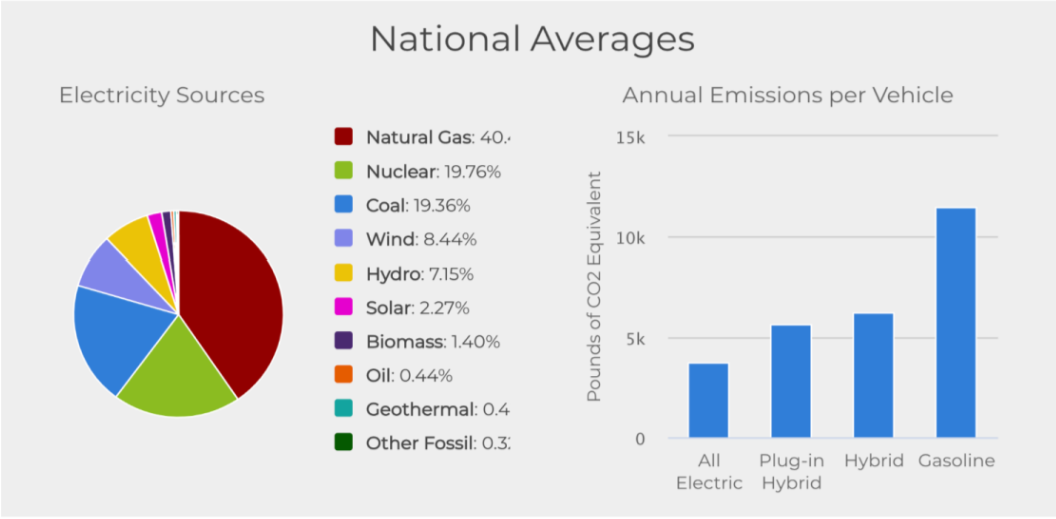Transportation Sector Emissions
By Sophia Huellstrunk
Greenhouse Gas Emissions in the United States
The US is warming rapidly in almost every region in the country (1) (see image 1). Some regions are experiencing faster increases than others. For instance, New Jersey's emissions have increased by 2 degrees since 1895, and it is one of the fastest increasing temperature states. More than 1 in 10 Americans, or 34 million people, are living in rapidly heating regions like New York City and Los Angeles, and 71 counties have already crossed the 2-degree threshold (4). In fact, historically, the US has emitted the most (3).
There are many emission types that cause this. Among these are carbon dioxide, methane, and nitrous oxide (see figure 2). However, in the US and globally, CO2 is the emission causing the most warming. Its concentration in the atmosphere has already reached 48% above its pre-industrial level (2).
The main causes of climate change in the US are transportation, electricity, and industry (5). (See figure 6.) In fact, 28% of GHG emissions come from transportation, and it is also the sector with the largest growth in GHG emissions between 1990 and 2018 (11). Among vehicles, the most emissions come from light-duty vehicles, with next most coming from medium-heavy-duty (8). (See figure 4.) Therefore, any approach to cutting greenhouse gas emissions must encompass both commercial and private transportation.
In order for the US to seriously cut emissions, it will have to regulate vehicular emissions. Therefore, this report will focus on transportation emissions in the US.
Proposal
In order to lower vehicular ghg emissions in the US, it will be necessary to encourage consumers to buy and producers to sell electric vehicles with a low carbon footprint. Our proposal is to:
Create more electric charging stations nationwide, and regulate electric charging stations by requiring they use 100% renewable energy
Create a minimum percentage threshold of total automobiles produced that must be electric automobiles, in order to increase supply and lower the price of electric vehicles
Create generous tax benefits for consumers who buy electric vehicles and companies that make more electric vehicles than required
Create a national lithium, cobalt, and other battery recycling effort to lower pollution during electric vehicle production, as well as producing electric cars using renewables
Transition the US military and government vehicles to electric vehicles
Transition companies to using electric vehicles in goods transportation minimum (9)
Electric Vehicles
There are many vehicles marketing themselves as more 'green'. For instance, there are fuel efficient cars (10) that use less gas, but this is still just a gas-utilizing car with tailpipe emissions. There are also pure electric vehicles, called EV's, PHEVs, which are plug-in hybrid vehicles that operate on both electricity and gas, and hybrids, which have both a gas engine and an electric motor (21). EV's produce no emissions at all from their tail pipes(12). Hybrids may lead to some tailpipe emissions, depending on whether they are running on gas or electricity (13). Image 5 shows that electric vehicles generally emit the least, and the emissions they do create (through production and energy usage) will be reduced through our proposal. Therefore, we propose the use of electric vehicles.
Regulating Electric Vehicle Production
Reducing the carbon footprint of electric vehicles will be one of the largest challenges to be addressed before they can become truly negligible emitters. Emissions are created from the electricity used during production. Companies should be regulated to ensure that electric vehicles are produced using electricity from renewables, such as wind and solar. Additionally, the materials used to build EV's can be harmful: lithium, cobalt, manganese, and other rare earth elements are mined for making batteries for EV's, which is why it takes almost twice as much energy to make an electric car than a gasoline car, as well as being more polluting and human rights concerns (19). In my own work on this issue, I have worked with a group in Serbia trying to prevent Rio Tinto, a mining company known for catastrophic environmental handling of lithium mining, from mining for lithium in a very fertile farm region in the middle of Serbia which would destroy the long time homes of many natives and create economic distress. Therefore, mining for EV batteries has both human rights and environmental implications. Some companies, like Panasonic and Tesla, are already reducing the amount of Cobalt in some of their batteries (19), but the government should regulate so that companies have to meet a maximum threshold in mining new Lithium and Cobalt, and transition to using recycled cobalt and lithium. This could be mitigated by creating a nation-wide lithium/cobalt battery recycling campaign, because while 99% of lead-acid batteries are recycled in the United States, only about 5% of lithium-ion batteries are recycled (20). Recycling these rare materials would decrease the carbon footprint of production and avoid human rights violations.
Lastly, I would propose that the government give tax benefits to companies for producing a certain volume of electric cars, so that prices for cars can start to decrease for consumers.
Regulating Electric Vehicle Charging
The other major polluter for electric vehicles is the electricity that charges them, which can vary dramatically depending on where the charging station is located (20). Currently, many electric vehicles get their electricity from natural gas (image 5). We propose that the government mandate that all electric charging stations use only renewable energy. Additionally, the amount of electricity chargers must increase to make EVs more convenient and encourage consumer buying. There are currently about 26,000 public charging stations (18), making EVs far harder to charge than gas cars. The government should incentivise companies to create more charging stations with tax benefits.
Other Benefits
The environmental benefits of EVs are clear. Even without some of the reforms we have proposed, they leave less of a carbon footprint than gasoline cars. However, charging an EV also costs less than tanking for gas, and it reduces America's dependence on oil, an important national security interest (15). The US imports about 3% of petroleum consumed, and transitioning to EVs would decrease US dependence on foreign oil (16).



